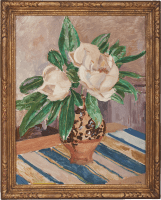This monumental still-life of magnolias was painted by Augustus John, one of the most prominent artists of the early twentieth century, and is a notable example of his work in this genre. It was chosen by the artist to be included in the annual exhibition of paintings at the Carnegie Institute in Pittsburgh in 1930, just a few years after he was awarded their Medal of First Class which bolstered his already soaring global reputation. For the last thirty years, Magnolias has been in the permanent collection at the Royal Scottish Academy, having previously been in the collection of British feminist Thelma Cazalet-Keir CBE, and is now offered here after it was deaccessioned in early 2023.
After building a considerable reputation as a society portrait painter, during the mid-1920s John turned his creative attention towards still-life painting. According to his partner and muse, Dorelia McNeill, John’s first flower painting was completed in 1925 during a visit to the Isles...
This monumental still-life of magnolias was painted by Augustus John, one of the most prominent artists of the early twentieth century, and is a notable example of his work in this genre. It was chosen by the artist to be included in the annual exhibition of paintings at the Carnegie Institute in Pittsburgh in 1930, just a few years after he was awarded their Medal of First Class which bolstered his already soaring global reputation. For the last thirty years, Magnolias has been in the permanent collection at the Royal Scottish Academy, having previously been in the collection of British feminist Thelma Cazalet-Keir CBE, and is now offered here after it was deaccessioned in early 2023.
After building a considerable reputation as a society portrait painter, during the mid-1920s John turned his creative attention towards still-life painting. According to his partner and muse, Dorelia McNeill, John’s first flower painting was completed in 1925 during a visit to the Isles of Ischia, and it subsequently became a frequent and stimulating alternative to live models.[1] By 1930, John had perfected his floral art and Richard Shone has subsequently drawn parallels between John's finest floral paintings and the late floral works of Edward Manet.[2]
The present work portrays two blooming magnolias, depicted in thick impasto. John returned to this composition, including the distinctive striped cloth and vase depicted here, regularly;[3] another, much smaller, still life of a magnolia depicted in the same pot was owned by the great interior decorator Syrie Maugham [fig. 1]. John’s collectors have historically included highly distinguished and esteemed individuals and the previous owner of this still life was no exception. Thelma Cazalet-Keir was a prominent British politician and suffragette whose tireless advocacy and activism made her a respected figure within the Women's Social and Political Union (WSPU).
[1] M. Easton and M. Holroyd, The Art of Augustus John. Kent: Westerham Press Ltd., p. 86.
[2] R. Shone quoted in M. Holroyd, Augustus John. London: Penguin Random House, 1996, p. 487.
[3] For further examples, see https://www.christies.com/lot/lot-5321032 and https://www.christies.com/lot/lot-4922831.















